Battle of the Mini-Mites! Antec ISK110-VESA vs. In-Win BQS656
Pros
Cons
Rating
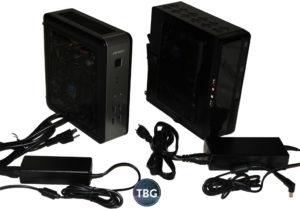
Introduction
Here at The Tech Buyer’s Guru, we are really big fans of the small computing movement. While it’s not exactly new, advances in the area of ultra-efficient processors and affordable solid-state drives have made building ultra-compact yet still lighting-quick PCs possible. For most PC builders, the mini-ITX format provides the best starting point for putting together a small PC. But mini-ITX cases actually come in a huge range of sizes, and many of the most recent products in this market are actually pushing the limits of what we’d consider small, catering to high-end gamers that simply want an ultra-powerful PC that happens to be a bit smaller than the typical full-size tower.
If that type of case interests you, we definitely understand, but we think the most interesting ITX cases are the ones at the other size of the size spectrum. In this review, we’ll be doing a head-to-head comparison of two of the smallest ITX cases on the market, the Antec ISK110-VESA and the In-Win BQS656. While there are smaller cases out there, they do not include power supplies, which the Antec and In-Win do. In fact, what we really like about these two particular cases is that they use external laptop-style power supplies, which in addition to allowing for smaller case dimensions also avoid the use of fans. And that’s not an insignificant fact, because the small fans required for compact internal power supplies are notoriously buzzy. We’ve worked with them in the past, and frankly, we wouldn’t use them again for our personal systems.
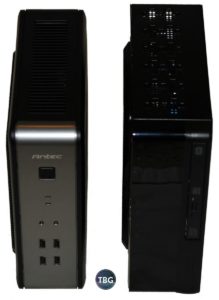
Description and Features
The Antec ISK110-VESA is technically the smaller of the two cases here, measuring 8.7″ x 3.1″ x 8.4″. The In-Win BQS656 is officially 8.9″ x 3.0″ x 8.3″, but that’s not counting its substantial extended vent on the left side panel. Unless you had both cases side by side as we did, though, you’d never know that they differed in size. While the Antec and In-Win cases are therefore incredibly similar, they have two notable differences: the power supply capacity and the data drive options. We’ll cover these differences one by one.
The In-Win’s power supply is rated at 120W versus the Antec’s 90W unit, and the extra 30W of headroom allow you to use a very different class of components. While In-Win takes a conservative stance on this, recommending CPUs at 65W or below, we actually tested a much more powerful configuration and had no issues whatsoever. With the Antec’s 90W power supply, on the other hand, we just weren’t willing to take a chance. The tested configurations are listed below. Interestingly, the difference in capacity also leads to the only significant difference in size between these two cases: the In-Win’s 120W unit is nearly twice as large as the Antec’s 90W unit.
The other major distinction between these two cases is the handling of data drives. The Antec allows the use of dual 2.5″-class drives, either hard drives or solid-state drives, while the In-Win allows the use of a single 2.5″-class drive, along with a slim-line optical drive. Which configuration is best really depends on the particular user. Need a media server? Then you’ll probably want both a quick SSD for your OS and a big hard drive for data. Want an all-around family PC? Then you’ll almost certainly want to include an optical drive.
Because these cases really cater to different users, we tested different hardware configurations in them. For the In-Win BQS656, we used the following components:
- CPU: Intel Core i5-4460 3.2GHz Quad-Core Processor
- Motherboard: ASRock H97M-ITX/ac
- RAM: Crucial Ballistix Sport 2x4GB DDR3-1600
- SSD: Samsung 850 Evo 250GB
- Optical Drive: Samsung Slim Internal DVD Writer
And for the Antec ISK110-VESA, we used these components:
- CPU: Intel Pentium G3258 3.2GHZ Dual-Core Processor
- Motherboard: MSI H81I ITX Motherboard
- RAM: Crucial Ballistix Sport 2x4GB DDR3-1600
- SSD: Crucial BX 100 120GB Solid-State Drive
Note that the Core i5-4460 CPU is basically twice the processor that the Pentium G3258 is. And while it is rated at 84W by Intel, versus 53W for the Pentium, both actually operate well below their ratings. In the case of the Core i5-4460, this isn’t suprising at all, given that it’s one of the least potent of the 84W-class processors in Intel’s product stack. They may all be rated at 84W, but they certainly don’t all use the same amount of power. We found in our testing that the G3258-based Antec system peaked at around 40W under an intense stress test, while the 4460-based In-Win system peaked at 81W. Both were well within the limits of their respective power supplies, and while you could probably squeeze the Core i5 into the Antec’s power envelope, we personally wouldn’t feel comfortable running it near its limit for extended periods of time.
One more thing we’ll note about the the power supplies is that the Antec PSU is a higher-quality model, offering up to 92% efficiency and ultra-low temperatures. That’s probably one reason the Antec system came in so much further below the CPU’s rated power draw than the In-Win system did. In-Win doesn’t list the BQS656 on its website, let alone provide specifications for its power supply.
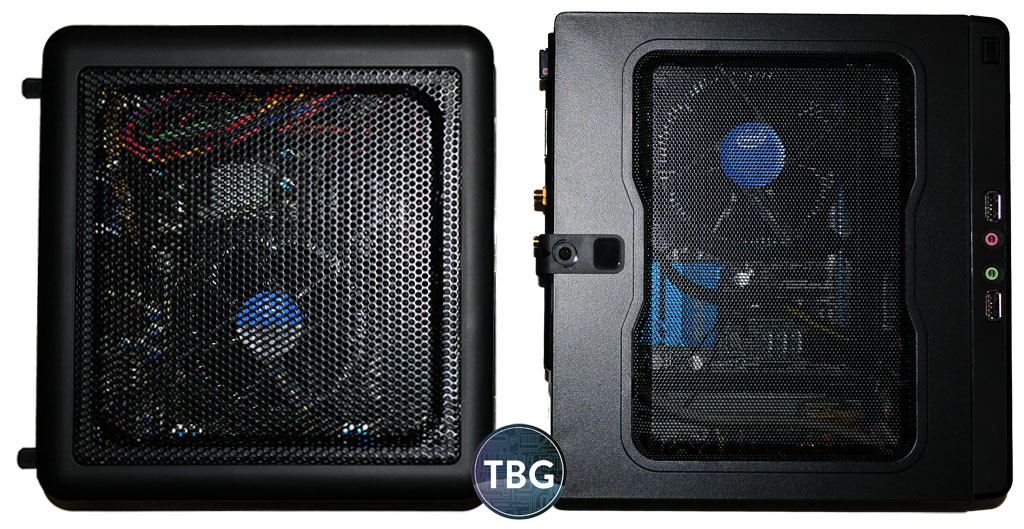
Both cases can be positioned vertically or horizontally, and while not shown in our photos, they both come with accessories to use with a VESA mount (including on the back of many monitors), or to keep them stable in a vertical configuration. Using the vertical stand accessories aren’t entirely necessary, but with the In-Win case at least, it does provide additional airflow through vents that would otherwise be blocked. As we’ll discuss on the next page, there’s a design problem with the In-Win relating to the mounting of the optical drive that makes horizontal use not quite ideal.
On the topic of venting, overall, Antec does a superior job. It offers a larger side panel vent (covering nearly the entire side panel), as well as a more free-flowing top vent that also happens to offer much more aesthetic appeal than the punched-metal vents of the In-Win. While neither of these systems is meant for high-end, power-hungry builds, given the lack of any active cooling besides the CPU fan, passive vent design is important, and Antec wins here.
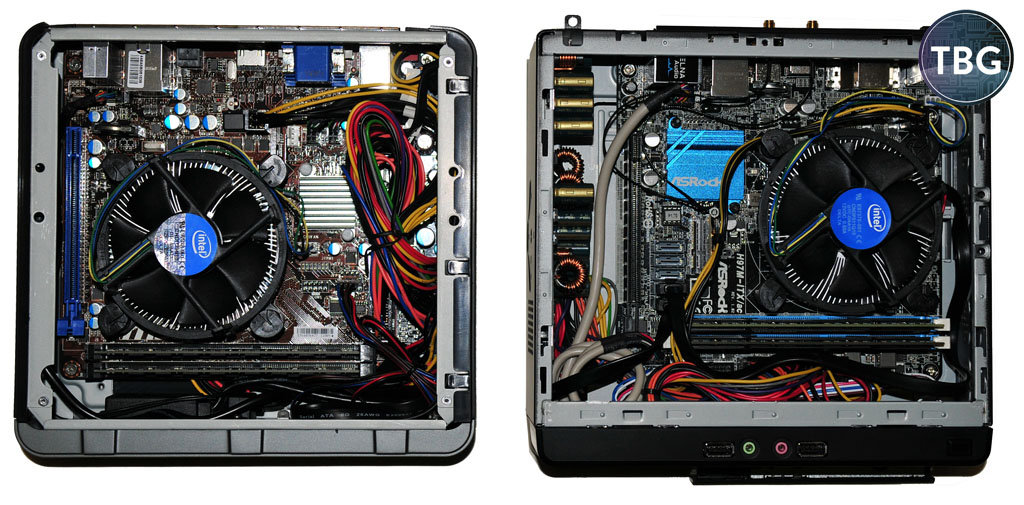
Performance
Now let’s talk a bit about performance, which in this situation really comes down mostly to the build experience. When examining our build photos, keep in mind that we used different motherboards, so the placement of components inside each case varies. It turns out that we caught a bit of a lucky break with our motherboard picks, as they placed the CPU mount on opposite ends, which just happened to keep the CPU away from the power supply cables in each of the respective cases.
Both cases were straight-forward to build in, but Antec gets another win here for the simplest of reasons: it includes a manual. We were shocked to find that the In-Win BQS656 didn’t come with one. Perhaps In-Win just expects you to close your eyes and use the Force to build a system in its ITX cases! While the limited build options presented by cases this small mean most builders will probably figure out where all the components and screws go, it’s not an ideal situation to keep users guessing.
On the other hand, there are some very nice internal features that prove that In-Win engineers knew what they were doing, even if their marketing team dropped the ball. Despite coming in at around the same size as the Antec, there’s clearly more room for cable management, making the overall build neater. The case also includes smartly-designed removable drive trays for both the 2.5″ drive and the optical drive, ensuring that they are both easy to install and very secure. The drive mounting mechanisms can be seen in the photo below. The In-Win case uses a spring-loaded snap-in tray that requies just one screw per tray, while the Antec uses a more conventional hard drive bracket that requires full removal to access either drive, and in fact had the tray pre-installed from the factory in the incorrect orientation, making cable attachment impossible.
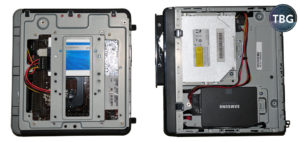
Another thoughtful touch in the In-Win case is the inclusion of all the correct power cables for maxed-out hardware configuration. That means a single full-size SATA power cable for an SSD or hard drive, plus a slim-line SATA power cable for a laptop-style optical drive. Most cases that support thin optical drives require the use of adapters, but because there’s only one configuration possible here (a single system drive a single optical drive), In-Win went ahead and did the right thing by including the right cables. That doesn’t mean there’s anything wrong with the Antec ISK110, as it has the right cables for the use of dual system drives, and no cables for an optical drive, since none will fit.
So once these systems are build up, how do they perform? Well, clearly, the quad-core-equipped In-Win was far superior, putting up benchmark numbers that were far beyond what the Pentium could muster. That being said, our little Pentium is actually overclockable, and we took it all the up to 4.2GHz without much trouble. That’s fun for tweakers, but the quad-core in the In-Win will be fun for those who actually care about maximum performance, as it can still handily outperform the Pentium in most tasks. We will note that the In-Win’s bigger power supply comes with one disadvantage besides the huge external power brick: it runs hotter. And it’s not just at load, which would potentially result from the more powerful processor. We also found that the power circuitry mounted inside the case generated a significant amount of heat at idle, when the system was pulling less than 20W. The heat is therefore not a result of being over-stressed, but a result of fairly low efficiency. Antec definitely wins in this regard, but of course has lower overall capacity.
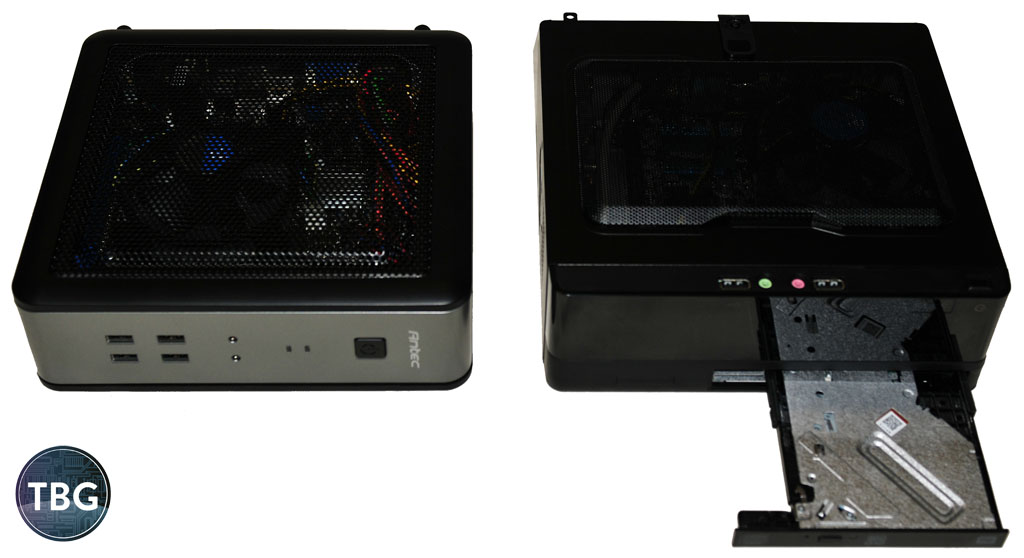
In this last photo, the keen observer will see the little In-Win design oversight we alluded to the previous page. Take a look at that extended optical drive. See the problem? Yes, indeed, it’s upside-down! And that wasn’t a building error, it’s a design error. In-Win’s mounting mechanism is easy to use and very secure, but alas, it looks like its engineers forgot to actually build a system using it! For that reason, you’ll probably want to set this case up vertically if you’ll be using the optical drive regularly. You can also see the different approaches to the placement of front panel buttons and ports. Antec has all of them on the front of the case (and has double the number of USB 2.0 ports), while In-Win has place them on the side of the case. Overall, the Antec approach makes more sense, particularly given that the In-Win really can’t be used horizontally with an optical drive, which is when its port placement would actually make some sense. Note that neither case offers a reset button, but this isn’t a critical omission, as holding down the power button can serve the same purpose.
Conclusion
Is either of these cases perfect? Absolutely not, but they’re both very, very good. We award each one 4.5 out of 5 stars, but for different reasons. The Antec ISK110 offers a fabulous design, with fit and finish far beyond what is typically available at its price point. The In-Win BQS656, on the other hand, doesn’t deliver any major design wins, nor is it a tremendous value play, but it combines so many great features into one case that it simply has no equal in terms of all-around versatility.
The Antec ISK110-VESA is available from Amazon for $67, and the In-Win BQS656 is available from Amazon for $80, as of our publication date. If you’d like the ultimate low-noise, ultra-compact system, you’ll definitely be happy with either of the two cases we tested, depending on your CPU and data drive requirements. Note that the In-Win BQS656 is also available with an internal 120W power supply; it costs $65 at Amazon as of our publication date. Likewise, Antec offers the slightly larger ISK300-150, available at Amazon for $67, which beats even the In-Win in terms of features, but also uses an internal power supply. Both of these cases will run far louder that the models we tested due to the use of internal power supplies.
If you’d like to learn more about all the latest mini-ITX build options, along with other great compact alternatives, check out our Small Form Factor PC Buyer’s Guides.

